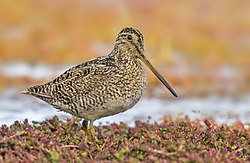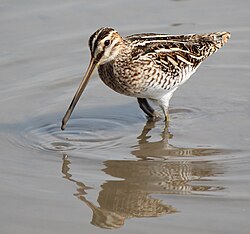Taxonomy
The name Gallinago was introduced by the French zoologist Mathurin Jacques Brisson in 1760 as a subdivision of the genus Scolopax. [2] Brisson did not use Carl Linnaeus's binomial system of nomenclature and although many of Brisson's genera had been adopted by ornithologists, his subdivision of genera were generally ignored. [3] Instead, the erection of the genus Gallinago for the snipes was credited to the German zoologist Carl Ludwig Koch in a book published in 1816. [4] But in 1920 it was discovered that the German naturalist Johann Samuel Traugott Frenzel had erected the genus Capella for the snipes in 1801. As his publication predated Koch's use of Gallinago it took precedence. [5] [6] The American Ornithologists' Union switched to Capella in 1921 [7] and in 1934 the American ornithologist James L. Peters used Capella for the woodcocks in his influential Check-list of Birds of the World. [8] This all changed in 1956 when the International Commission on Zoological Nomenclature ruled that Gallinago Brisson 1760 should have priority for the genus with the common snipe as the type species. [9] The scientific name gallinago is Neo-Latin for a woodcock or snipe from Latin gallina, "hen" and the suffix -ago, "resembling". [10]
The genus contains 18 species: [11]
| Image | Scientific name | Common name | Distribution |
|---|
 | Gallinago imperialis | Imperial snipe | northern Andes |
 | Gallinago jamesoni | Jameson's snipe | northern Andes |
 | Gallinago stricklandii | Fuegian snipe | Chile to Tierra del Fuego |
 | Gallinago solitaria | Solitary snipe | southern Siberia, Mongolia and northern China
winters to eastern Alpide belt, northeast Asia and southern China |
 | Gallinago nemoricola | Wood snipe | eastern Himalayas to central China ;
winters to southern India and Indochina |
 | Gallinago media | Great snipe | northwestern palearctic ;
winters to sub-Saharan Africa |
| - | Gallinago megala | Swinhoe's snipe | Mongolia, southern Siberia and Manchuria
winters to Indomalaya and northern Australia |
 | Gallinago stenura | Pin-tailed snipe | Siberia ;
winters to Indomalaya |
 | Gallinago hardwickii | Latham's snipe | Sakhalin and Japan ;
winters to eastern Australia |
 | Gallinago nigripennis | African snipe | Sub-Saharan Africa |
 | Gallinago gallinago | Common snipe | northern palearctic ;
winters to southern palearctic and Africa |
 | Gallinago delicata | Wilson's snipe | North America
winters to norwestern South America |
 | Gallinago undulata | Giant snipe | South America |
 | Gallinago nobilis | Noble snipe | northern Andes |
 | Gallinago andina | Puna snipe | puna grassland |
 | Gallinago macrodactyla | Madagascar snipe | eastern Highlands of Madagascar |
 | Gallinago paraguaiae | Pantanal snipe | South America |
 | Gallinago magellanica | Magellanic snipe | from Chile to Tierra del Fuego and Falkland Islands |
|
This genus contains the majority of the world's snipe species, the other two extant genera being Coenocorypha , with three species, and Lymnocryptes , the jack snipe. Morphologically, they are all similar, with a very long slender bill and cryptic plumage. Most have distinctive displays, usually given at dawn or dusk. They search for invertebrates in the mud with a "sewing-machine" action of their long bills.
Fossil bones of some undescribed Gallinago species most similar to the great snipe have been recovered in Late Miocene or Early Pliocene deposits (c. 5 mya) of Lee Creek Mine, USA. The large West Indian species Gallinago kakuki went extinct during the late Quaternary period, and despite its distribution may actually be more closely related to Old World snipe species than New World ones.
This page is based on this
Wikipedia article Text is available under the
CC BY-SA 4.0 license; additional terms may apply.
Images, videos and audio are available under their respective licenses.




















